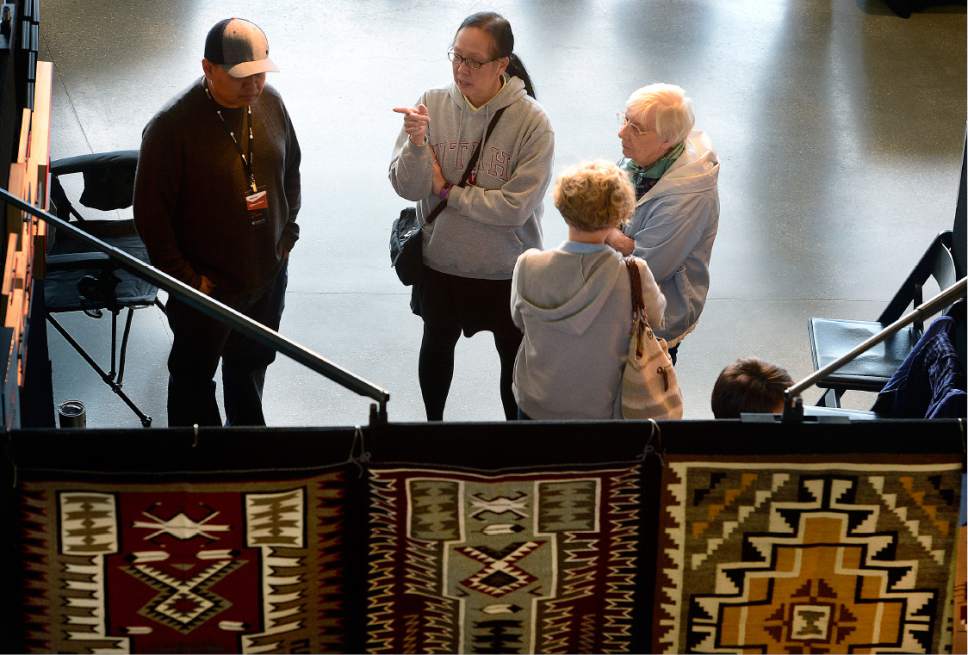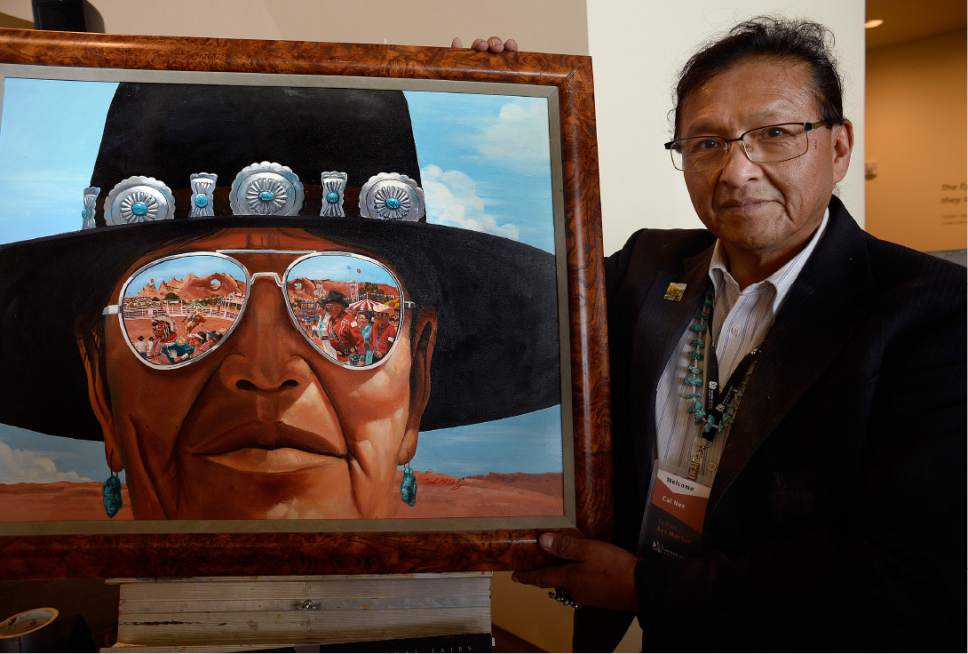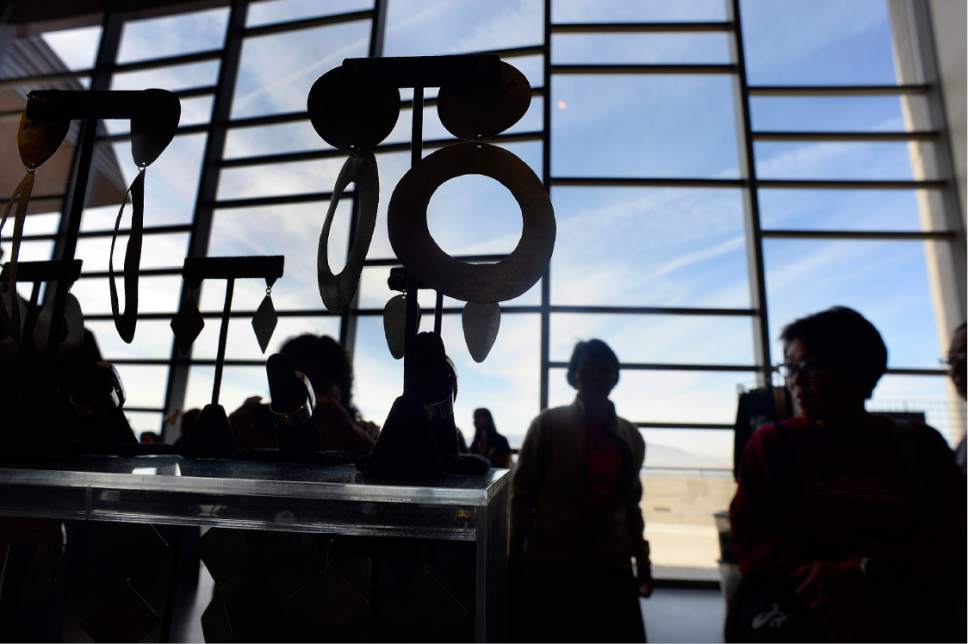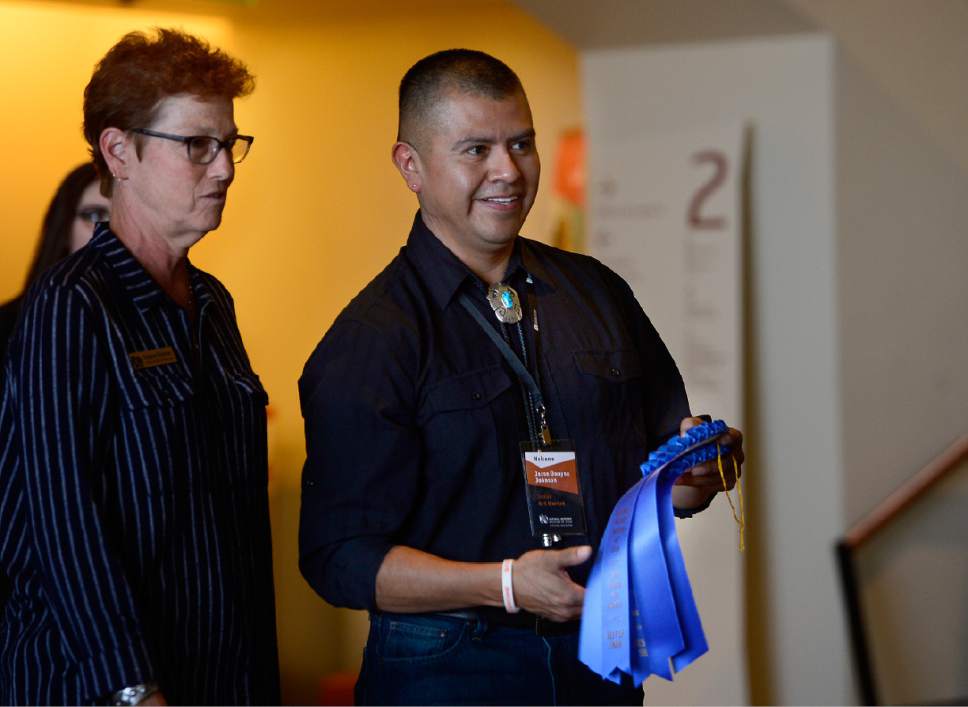This is an archived article that was published on sltrib.com in 2016, and information in the article may be outdated. It is provided only for personal research purposes and may not be reprinted.
Sky, earth, bears, buffalo. Native Americans hold their landscapes in reverence that is reflected in their art.
Gilmore Scott, a Navajo from Montezuma Creek, Utah, paints striking landscapes that capture the breadth and raw power of the Southwest desert country.
"All indigenous people incorporate Mother Nature into their traditions," he said. "Certain features of the landscape and the colors tell stories, like that of our four sacred mountains — and our rivers have stories, too."
Scott was one of 26 artists from 12 tribes invited to the fourth annual Indian Art Market at the Natural History Museum of Utah on Saturday.
In a 12-inch-by-36-inch acrylic work Scott painted a long, orange horizon with three tiny buffalo beneath a huge blue sky.
Billowing clouds symbolize the great buffalo herds that once roamed the continent. "They are looking down from above," he said.
In two other frames painted with watercolors and acrylic on birch, Scott depicts storms across a great expanse. One is a female storm, he said, with gentle rains and cool colors. The other is a male storm with dark colors and lightning.
Weather, Scott explained, plays a central role to life on the Navajo Reservation.
Silver jewelry with inlaid semi-precious stones is a Navajo signature appreciated across the country. It, too, takes into account nature and Indian tradition, said Jeremy Harrison of Albuquerque, whose father Jimmie Harrison entered the show with dazzling rings, bracelets and pendants.
One pendant depicted Monument Valley at night with the Big Dipper constellation overhead.
A bracelet with multi-colored stone portrayed a yei-bei chai, a Navajo supernatural being seen as a masked dancer used in ceremonies. "It's a deity," Harrison explained.
Manuel Weahkee of Bloomfield, N.M., is Hopi and likes to carve animals from stone. He uses Colorado marble, turquoise, azurite and zebra rock, among other minerals.
Mostly he carves bears.
"Before God made man, brother bear was the guardian over all living creatures," Weahkee explained.
Among his works are what he calls a unique standing bear that is his signature.
"I like the standing bear," he said. "He doesn't have very good eyesight, but he has a good nose."
There is another reason Weahkee carves the standing bear. He once fell over a downed tree and came face to face with a bear. Both became terrified, he recalled. The bear stood up for a moment, then he and the bear ran off in opposite directions.
Native clays are key to the work of Roxanne Seoutewa and Carlos Laate, Zuni potters from the pueblo of Zuni, 45 miles north of Gallup, N.M.
Their works are not thrown from a wheel. Rather, their method uses rope to shape their sculptures. They employ yellow clay that turns red when fired, along with white clay that remains light. Yucca fruit is used as a resin with natural dyes for color.
Among Laate's works is a small turtle that represents fertility and longevity, he explained. Looking closely, he points to a dragonfly and tadpoles and rainclouds that decorate the turtle's shell. The dragonfly, he noted, will bring rain.
Also among those at Saturday's Indian Art Market was 85-year-old Glenna Begay, a rug weaver from Upper Black Mesa in Arizona. She doesn't speak English but her daughter, Salina Begay, also a weaver, explained that they begin by shearing their own sheep to make wool fibers for thread.
A 42-inch-by-31-inch rug took Glenna about three weeks to weave. That painstaking handiwork can begin only after the yarn has been spun and dyed with colors from local plants.
The designs incorporated into the weaving are traditional patterns that also tell stories, Salina said.
One she pointed to is called Teec Nos Pos, a place where some weavers come from — the design incorporates bear claws and lightning.
Native American tradition is one of beauty and sorrow, as shown in the photographs of Peggy Fontenot, who says she is Patawomeck-Potawatoni, and lives in Santa Monica, Calif. Her images reveal the hardship and heartbreak of Indians squeezed into white society. They also show the pride that many carry forward as they work to keep their traditions alive.
The winners:
Best of Show • Jesse Dwayne Johnson, Zuni tribe, petit point necklace and earring set
Second place • Jeremy Rosetta, Santo Domingo Pueblo, belt with double sided inlay, overlay and tufa casted pieces
Third place • Susan Hudson, Navajo, quilt - titled: "Nii Da Ba Hii Ba'Hane or Warrior Story"



















